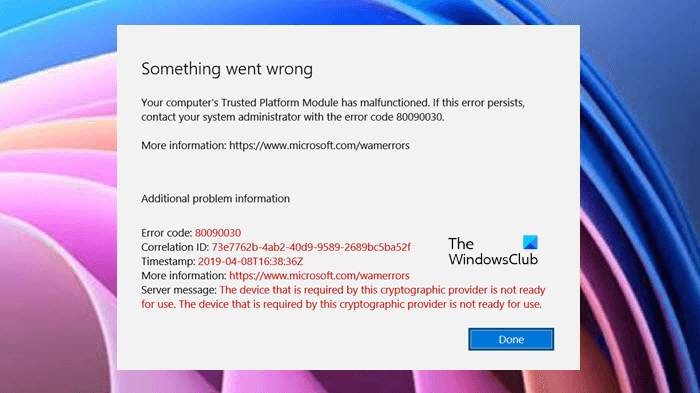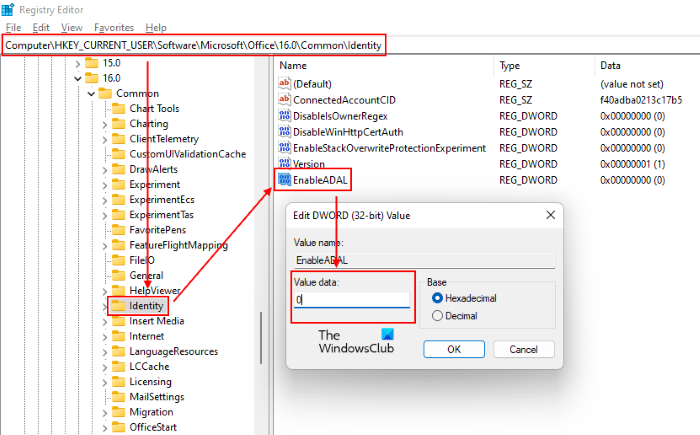In this article, we will show you how to fix Trusted Platform Module has malfunctioned, Error 80090030, The device that is required by this cryptographic device is not ready for use in Windows 11/10. According to the affected users, this error message occurs when they sign into their Teams, Outlook account on Outlook desktop or any Microsoft 365 app. This error prevents them from signing into their account.
The error message on the screen is:
Something went wrong. Your computer’s Trusted Platform Module has malfunctioned. If this error persists, contact your system administrator with the error code 80090030. The device that is required by this cryptographic provider is not ready for use.

Your computer’s Trusted Platform Module has malfunctioned, Error 80090030
The following solutions will help you get rid of this issue:
- Disconnect and reconnect your Work or School account
- Disable ADAL or enable Multi-Factor Authentication
- Clear your credentials
- Update TPM Firmware
Let’s see these solutions in detail.
1] Disconnect and reconnect your Work or School account
Sometimes, the Trusted Platform Module fails to initialize the connection protocols due to server issues. In such a case, you may receive error messages like this one. If the error is occurring due to this issue, disconnecting and reconnecting your Work or School account can fix it.
Follow the steps below:
- Launch the Windows 11/10 Settings app.
- Go to “Accounts > Access Work or School.”
- Select the account that you want to disconnect and then click on the Disconnect button.
- Now, click on the Connect button on the Access Work or School page in Settings. Follow the on-screen instructions to add a Work or School account.
Now, check if the issue persists.
Read: How to Run TPM Troubleshooter in Windows 11
2] Disable ADAL or enable Multi-Factor Authentication (MFA)
The major cause reported of this problem is the authentication issue. This can be fixed either by disabling the ADAL or by enabling the MFA (Multi-Factor Authentication). This solution has been proven effective for a lot of users. Hence, you should also try this.
Both of these methods are explained below:
Disable ADAL via Registry Editor
This solution requires some modifications in the Registry Editor. Therefore, before you proceed, we recommend you create a system restore point and backup your Registry.

Now, follow the steps below:
Click on the Windows Search and type Registry Editor. Select Registry Editor from the Search Results. Click Yes in the UAC prompt.
Copy the following path and paste it into the address bar of the Registry Editor. After that, hit Enter.
HKEY_CURRENT_USER\Software\Microsoft\Office\16.0\Common
Expand the Common key and select the Identity subkey. Right-click in the empty space on the right side and go to “New > DWORD (32-bit) Value.” Right-click on the newly created value and select Rename. Type EnableADAL.
By default, the Value Data of EnableADAL should be 0. If not, double-click on it and enter 0 in its Value Data. Click OK to save the changes.
Exit the Registry Editor.
This should fix the issue. If the issue still exists, enable the Multi-Factor Authentication.
Enable Multi-Factor Authentication
Some users have reported that the error occurred because MFA was disabled on their Microsoft 365 accounts. By default, the MFA is turned on for security reasons. Check if it is enabled or disabled. If you find the MFA disabled on your account, consider enabling it and see if it fixes the issue. The steps for this are listed below:
- Login to Microsoft 365 admin center.
- Click Show all to expand it and then select Azure Active Directory Admin Center.
- Now, go to “Azure Active Directory > Properties > Manage Security Defaults.”
- On the right side, the switch under the Enable Security Defaults should be set to Yes. If not, click on it to change its position from No to Yes. This will enable the MFA on your account.
- Now, scroll down and click on the Save button.
Related: Fix Alert! TPM device is not detected error on Dell computers.
3] Clear your credentials
The issue might also be associated with the cache of your account. Hence, we suggest you clear your old credentials and see if it brings any changes.
The steps to clear the old credentials are listed below:
- Open the Control Panel.
- Select Large icons in the View by mode.
- Click Credential Manager.
- Select Windows Credentials.
- Expand each credential under the Generic Credentials section and click Remove. You have to delete all the credentials under the Generic Credentials section.
- When you are done, close the Control Panel and restart your computer.
- Now, log in to your account in the Outlook app and check if the issue persists.
4] Update TPM Firmware
If the problem still persists. there may be some problem with your TPM module. Hence, you should consider updating the TPM Firmware.
We hope this helps.
Related posts:
- Trusted Platform Module has malfunctioned, Error 80090034, Encryption failed
- Trusted Platform Module has malfunctioned, Error 80090016, Keyset does not exist
How do I fix malfunctioned TPM?
To fix a fix malfunctioned TPM, do the following:
- Open Settings > Update & Security > Windows Security > Device Security.
- Under Security processor > Select Security processor details > Security processor troubleshooting.
- Select Clear TPM.
- Restart the device and try to activate Microsoft 365 again.
How do I update a Trusted Platform Module?
You can update the Trusted Platform Module in any of the following ways:
- By installing the latest Windows Update
- By installing the firmware updates from the manufacturer’s website
We have already talked about this above in this article.
I hope this helps.
Read next: TPM missing or not showing in BIOS.
Leave a Reply